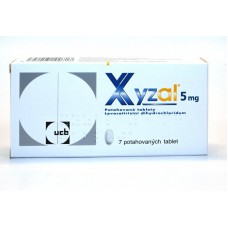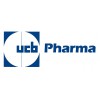Expiration date: 04/2025
Structure and Composition:
Tablets, film-coated. 1 tablet contains active substance: Levocetirizine dihydrochloride 5 mg
Excipients: MCC - 30 mg of lactose monohydrate - 63.5 mg Colloidal silicon dioxide - 0.5 mg Magnesium stearate - 1 mg
shell: Opadry Y-1-7000 (Hypromellose (E464) - 62,5% titanium dioxide (E171) - 31,25% macrogol-400 - 6.25%) - 3 mg
in blisters 7 or 10 pieces. a stack of cardboard packaging 1 or 2.
Drops for oral administration. 1ml contains active substance: Levocetirizine dihydrochloride 5 mg
Excipients: sodium acetate, acetic acid, glycerol, propylene glycol, methyl parahydroxybenzoate 85% sodium saccharin propyl parahydroxybenzoate Purified water
In bottle - dark glass of 10 or 20 ml in a cardboard bundle one bottle.
Description pharmaceutical form:
Tablets, film-coated: oval shaped, film-coated white or almost white. On one side of the tablet embossed marking «Y».
Drops: nearly colorless slightly opalescent solution.
Pharmacokinetics:
Pharmacokinetic parameters of levocetirizine vary linearly and do not differ from the pharmacokinetics of cetirizine.
Suction. After oral administration, the drug is rapidly and completely absorbed from the gastrointestinal tract. Food does not affect the completeness of absorption, although its speed is reduced. In adults, after a single dose of the drug at a therapeutic dose (5 mg) Cmax in plasma is 270 ng / ml and is achieved in 0.9 hours after repeated administration at a dose of 5 mg - 308 ng / ml. Css achieved within 2 days.
Distribution. Levocetirizine is 90% bound to plasma proteins. Vd is 0.4 L / kg. Bioavailability is 100%.
Metabolism. Small amounts (<14%) is metabolized in the body by N- and O-dealkylation (unlike other antagonists of H1 histamine receptors, are metabolized in the liver via cytochrome systems) with a pharmacologically inactive metabolite. Due to the low level of metabolism and absence of metabolic potential of the interaction of levocetirizine with other drugs is unlikely.
Withdrawal. In adults, the T1 / 2 of (7,9 ± 1,9) h in young children T1 / 2 is shortened. In adults, the total clearance of 0.63 mL / min / kg. Approximately 85.4% of the dose of the drug excreted by the kidneys in unchanged form by glomerular filtration and tubular secretion of about 12.9% - through the intestines.
In patients with renal impairment (Cl creatinine <40 ml / min), the clearance of the drug decreases, and T1 / 2 longer (for example, patients on hemodialysis, the total clearance is reduced by 80%), which requires a corresponding change in the dosing regime. Less than 10% of levocetirizine removed during a standard 4-hour dialysis procedure.
Description of the pharmacological actions:
Levocetirizine - the active ingredient of the drug Ksizal - is the R-enantiomer of cetirizine, which belongs to a group of competitive histamine antagonists and blocking of H1-histamine receptors. Affinity for histamine H1-receptors have levocetirizine 2 times higher than that of cetirizine.
Levocetirizine influences gistaminozavisimuyu step allergic reactions and also reduces the migration of eosinophils, vascular permeability reduces, limits release of inflammatory mediators and cytokines (VCAM-1 and others.).
Levocetirizine prevents the development and facilitates the allergic reactions, has protivoekssudativnoe, antipruritic action, virtually no anticholinergic and antiserotoninovogo action. At therapeutic doses, virtually no sedative effect.
Testimony:
- treatment of symptoms year-round (persistent) and seasonal (intermittent) allergic rhinitis and allergic conjunctivitis, such as itching, sneezing, nasal congestion, rhinorrhea, lacrimation, conjunctival hyperemia
- hay fever (hay fever).
- urticaria, including chronic idiopathic urticaria, angioedema
- other allergic dermatitis, accompanied by itching and rash.
Contraindications:
Common to all dosage forms
- hypersensitivity to levocetirizine or a piperazine derivative, as well as other components of the drug
- end-stage renal failure (Cl creatinine <10 ml / min)
- pregnancy (due to lack of data on efficacy and safety).
Precautions: chronic renal failure (requires correction mode), older age (perhaps decreased glomerular filtration).
For tablets, film-coated Optional:
galactosemia, or severe lactose intolerance
Children up to age 6 years.
For further drops:
Children under 2 years (due to limited data on efficacy and safety)
Application of pregnancy and breastfeeding:
Experimental studies in animals did not reveal any direct or indirect adverse effects of levocetirizine on the developing fetus, as well as development in the postnatal period during pregnancy and childbirth are not changed.
Adequate and well-controlled clinical studies on the safety of the drug during pregnancy has not been so levocetirizine should not be used during pregnancy.
Levocetirizine is excreted in breast milk, so its use is possible only if the expected benefit to the mother outweighs the potential risk to the child.
Side effect:
Possible side effects are listed below by body system and frequency of occurrence: often (& ge1 / 10), uncommon (& ge1 / 100, <1/10), rare (& ge1 / 1000, <1/100), rarely (& ge1 / 10000, <1/1000).
From the nervous system: rarely - headache, fatigue, drowsiness, rarely - fatigue very rare - aggression, agitation, hallucinations, depression, convulsions.
From the sensory organs: rarely - visual impairment.
From the digestive system: rarely - dry mouth rare - abdominal pain, very rarely - nausea, diarrhea, hepatitis.
From the CCC: rarely - tachycardia.
With the respiratory system: very rarely - dyspnea.
From the musculoskeletal system: very rarely - myalgia.
On the part of metabolism: rarely - weight gain.
From the laboratory parameters: very rarely - changes in liver function tests.
Allergic reactions: rarely - itching, rash, urticaria, angioedema, anaphylaxis.
Drug Interactions:
The study of the interaction of levocetirizine with other drugs have not been conducted. In the study of drug interactions racemate cetirizine with pseudoephedrine, cimetidine, ketoconazole, erythromycin, azithromycin, glipizide and diazepam clinically significant adverse interactions have been identified.
When concomitant administration with theophylline (400 mg / day), total clearance of cetirizine is reduced by 16% (theophylline kinetics does not change).
In some cases, while the use of levocetirizine with alcohol or drugs, oppressive central nervous system, may increase their effect on the central nervous system, although it is not shown that the racemate cetirizine potentiate the effect of alcohol.
Dosage and administration:
The inside is not liquid, with food or on an empty stomach, with a little water. teaspoon be used for the drug in the form of droplets. If necessary, the dose may be diluted in a little water just before use.
Adults and children over 6 years - a daily dose of 5 mg (1 tablet or 20 drops.).
Children aged 2 to 6 years of age - 1.25 mg (5 drops), 2 times a day, daily dose - 2.5 mg (10 drops).
Overdose:
Symptoms: drowsiness (adults), agitation and anxiety, changing sleepiness (in infants).
Treatment: Immediately after ingestion of the drug is necessary to wash out the stomach or cause an artificial vomiting. It recommended the appointment of activated carbon, the holding of symptomatic and supportive therapy. No specific antidote. Hemodialysis is not effective.
Special instructions:
Requires compliance with caution, while the use of alcohol (see. "Interaction").
Effects on ability to drive vehicles and management mechanisms. When an objective assessment noted no significant impact of the drug on the ability to drive vehicles and management mechanisms when taken in the recommended dosage. Nevertheless, during the period of ingestion it is advisable to refrain from activities potentially hazardous activities that require high concentration and psychomotor speed reactions.
Shelf life:
After opening the package 3 months.






